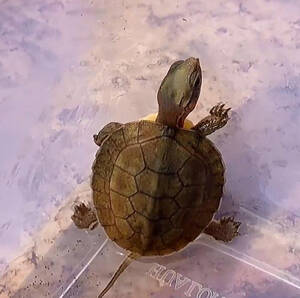Palea steindachneri
IUCN
LCBasic Information
Scientific classification
- name:Palea steindachneri
- Scientific Name:Palea steindachneri,wattle-necked softshell turtle,Trionyx steindachneri Siebenrock,Mountain Rui, Rui fish, soft-shelled turtle, round fish, turtle, tortoise
- Outline:Testudines
- Family:Testudinata Trionyx
Vital signs
- length:120-350mm
- Weight:About 1.5 kg
- lifetime:60years
Feature
Its appearance is very similar to that of the Chinese soft-shelled turtle, commonly known as "turtle". It is round in shape, but slightly larger and thicker.
Distribution and Habitat
In China, it is distributed in Guangxi, Guangdong, Yunnan, Guizhou, Taiwan and Hainan. Abroad, it is distributed in Laos and Vietnam.
It lives in rivers, lakes and streams, and especially likes to live in clear flowing waters.
Appearance
The head is relatively large and triangular, with smooth skin on the back of the head, a protruding snout, and a long neck with large and dense grains on both sides of the base of the neck. The carapace is oval, with a flat top and a row of obvious thick grains on the front edge, and a skirt. The plastron has 4-6 corpora callosum. Both the front and rear limbs have 3 claws. The carapace is olive green or gray-green, with black spots or none, and the plastron is white with black cloud spots.
Details
The mountain softshell turtle is a cold-blooded animal. When the temperature drops to 12℃, it will hibernate under the sand or stones, so people also call it the sand softshell turtle. When the temperature rises to 18-20℃ in the next spring, it will wake up and start looking for food. The optimum temperature for the mountain softshell turtle is 25-32℃. During the optimum temperature period, the mountain softshell turtle eats the most vigorously. If the water temperature is higher than 37-38℃, there is a risk of heat death.

The mountain softshell turtle is an omnivorous animal that mainly feeds on animal bait. In nature, it eats small fish, shrimps, insects, worms, etc.; in artificial breeding, it is good at eating golden apple snail meat, field snail meat, snail meat, clam meat, fish meat, animal scraps, earthworms, fly maggots, etc. The mountain softshell turtle usually eats a lot at night, and the feeding amount is generally 5-8% of its body weight.
Due to various endangered factors, the wild population of mountain softshell turtles in Guangxi, China has been decreasing year by year, and only occasionally they are caught by mistake. The wild mountain softshell turtles are not widely distributed, grow slowly, and have weak reproductive capacity, resulting in limited production. In addition, the resources are severely damaged due to unplanned overfishing in the production areas. Therefore, the artificial breeding of mountain softshell turtles has important social significance.
In order to protect wild mountain softshell turtle resources, Guangdong Province, China has established the county-level nature reserve of Ruyuan Mountain softshell turtle in Buguan City, the Longtankou Mountain softshell turtle nature reserve in Yuancheng District, Heyuan City, the Jiutan Mountain softshell turtle nature reserve in Lianping County, and the Youxi Mountain softshell turtle nature reserve in Lianping County.
Listed in the second level of the "List of National Key Protected Wildlife in China" (only for wild populations).
Listed in the "China Red List of Biodiversity - Vertebrate Volume" (Reptiles) - Endangered (EN).
Listed in the "List of National Key Protected Aquatic Wildlife under Artificial Breeding (First Batch)" (November 13, 2017).
Listed in the "China Red Data Book of Endangered Animals" - Endangered (EN).








